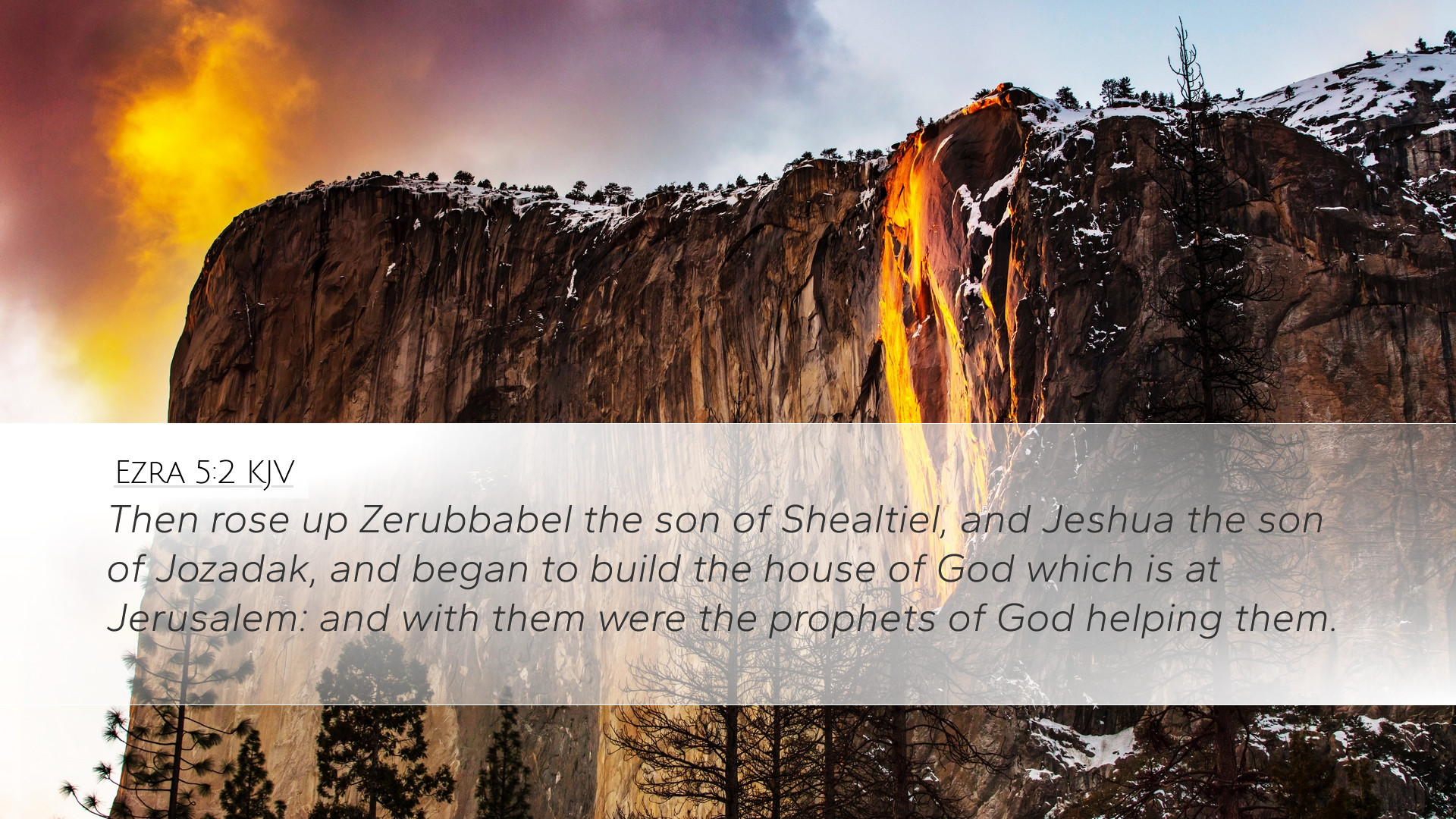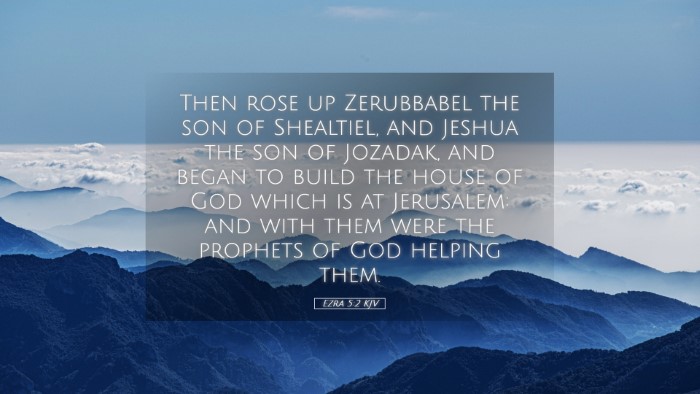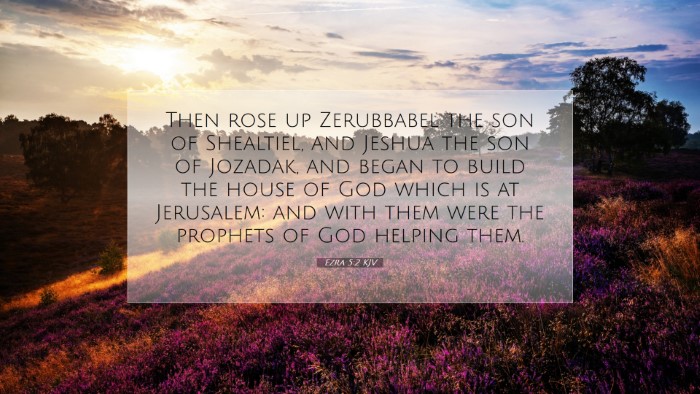Old Testament
Genesis Exodus Leviticus Numbers Deuteronomy Joshua Judges Ruth 1 Samuel 2 Samuel 1 Kings 2 Kings 1 Chronicles 2 Chronicles Ezra Nehemiah Esther Job Psalms Proverbs Ecclesiastes Song of Solomon Isaiah Jeremiah Lamentations Ezekiel Daniel Hosea Joel Amos Obadiah Jonah Micah Nahum Habakkuk Zephaniah Haggai Zechariah MalachiEzra 5:2
Ezra 5:2 KJV
Then rose up Zerubbabel the son of Shealtiel, and Jeshua the son of Jozadak, and began to build the house of God which is at Jerusalem: and with them were the prophets of God helping them.
Ezra 5:2 Bible Commentary
Commentary on Ezra 5:2
Verse Reference: Ezra 5:2 - "Then rose up Zerubbabel the son of Shealtiel, and Jeshua the son of Josedech, and began to build the house of God which is at Jerusalem: and with them were the prophets of God helping them."
Overview
This verse marks a pivotal moment in the history of post-exilic Judah, as the initiatives taken by Zerubbabel and Jeshua signal the resumption of the rebuilding of the Temple in Jerusalem. The involvement of the prophets indicates divine backing and the need for spiritual encouragement amidst the physical labor.
Historical Context
The Israelites had returned from Babylonian captivity, impelled by a decree from King Cyrus. However, the building of the Temple had stalled due to opposition and apathy. As the historical context indicates, the rebuilding began in earnest as the leadership brought forth by Zerubbabel and Jeshua, both significant figures in the lineage of David and the priestly line respectively, mobilizes the people.
Commentary Insights
Matthew Henry's Insights
Matthew Henry describes Zerubbabel as the governor and Jeshua as the high priest, emphasizing the importance of their roles in invigorating the remnant community. According to Henry:
- Leadership: The dual leadership of kingly (Zerubbabel) and priestly (Jeshua) figures symbolizes the holistic restoration God intends for His people.
- Divine Assistance: The mention of prophets provides a vital aspect of divine guidance; they assist the builders not merely in practical matters but spiritually, reinforcing the confidence of the people in God’s plans.
- Physical and Spiritual Renewal: The act of rebuilding the Temple is viewed as an essential step towards spiritual renewal, symbolizing the restoration of Israel’s relationship with Yahweh.
Albert Barnes’ Commentary
Albert Barnes provides additional insights, particularly regarding the opposition faced by the Jews. He emphasizes the perseverance of the Jewish exiles:
- Resistance: Despite previous opposition, the rise of Zerubbabel and Jeshua represents a faith-filled response. Barnes notes that true obedience often brings conflict but that God rewards diligence in faithfulness.
- Prophetic Encouragement: The role of the prophets is crucial; they serve as instruments of God's will and reassurance to the people, encouraging them to not only rebuild physically but also to restore their hearts to God.
- Vision and Mission: Barnes contends that the teamwork depicted here—a collaboration between civil and spiritual leaders—fosters a shared vision, essential for fulfilling God's purpose in restoration.
Adam Clarke's Perspective
Adam Clarke adds a layer of depth by considering the significance of the names and roles described:
- Zerubbabel’s Heritage: Clarke points out that Zerubbabel, as a descendant of David, highlights the continuity of God's covenant. His role signifies a restoration of rightful leadership.
- The Role of Jeshua: Jeshua being a descendant of Aaron connects worship and sacrifice to the restoration effort, underscoring that physical rebuilding cannot be separated from spiritual revival.
- Collective Action: Clarke stresses the importance of community in God's plan; this effort reflects a collective commitment to worship, indicating that God’s work requires unity among His people.
Theological Implications
This verse and its commentary shed light on significant theological themes:
- Theological Restoration: The act of rebuilding the Temple serves as a metaphor for the restoration of God's presence among His people. It invites believers to consider what “temples” they are called to rebuild in their lives and communities.
- God’s Sovereignty: The involvement of prophets signifies God’s unwavering commitment to His promises. Even amidst discouragement, God raises leaders and sends encouragement, asserting His sovereign control over history.
- The Role of Leadership: This narrative illustrates the need for strong, faithful leaders in church and community settings, highlighting that spiritual leadership is indispensable in times of restoration.
Conclusion
Ezra 5:2 invites readers into a rich tapestry of leadership, faith, and collective purpose. It challenges modern readers—pastors, theologians, and students alike—to reflect on their roles in God's redemptive plan. Are we, like Zerubbabel and Jeshua, committed to leading the way in rebuilding the spiritual and communal lives of those around us? The echoes of their faith and the support of the prophets serve as a solemn reminder of the divine partnership in all our endeavors towards restoration.


